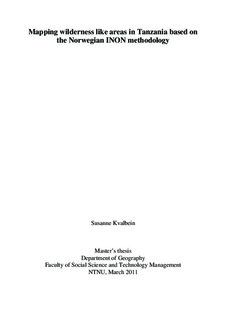Mapping wilderness like areas in Tanzania based on the Norwegian INON methodology
Master thesis
Permanent lenke
http://hdl.handle.net/11250/265407Utgivelsesdato
2011Metadata
Vis full innførselSamlinger
- Institutt for geografi [1112]
Sammendrag
The purpose of this master’s thesis was to produce a national wilderness map of Tanzania by using a Norwegian method for mapping wilderness like areas, called Inngrepsfrie naturområder i Norge (INON). In English this means Areas without major infrastructure development in Norway. There are currently no national wilderness maps of Tanzania, just maps on regional or global scale. The INON methodology was assessed in relation to Tanzanian conditions, and to some degree compared with Landscan population data, protected areas from World Database on Protected Areas (WDPA), as well as the Last of the Wild dataset from the Human Footprint project.
The INON methodology is based solely on distance from elements defined as major infrastructure development by the Directorate of Nature Management (DN) in Norway, and its methodology is much simpler than other methods for mapping wilderness, such as for instance GLOBIO and the Human Footprint. Its simplicity makes it easy to use, but also insufficient for decision making. It can be used as a reference map, indicating where to find possible wilderness like areas, but additional information is needed before making a decision.
As the INON methodology is based on distance from infrastructure, this raises some issues in a Tanzanian context. This works in Norway because people usually live in close proximity to infrastructure. However, this is not always the case in Tanzania, where the infrastructure is not yet fully developed. Many people live in villages not connected to the road network or other infrastructure defined by DN. These areas will show up in the map as wilderness like areas, when they are actually filled with human settlements. To solve such issues, the INON methodology must be adapted to Tanzanian conditions before it can be used in land use management and planning.
